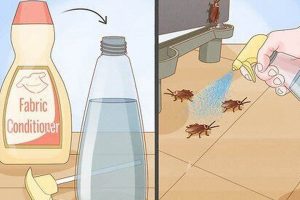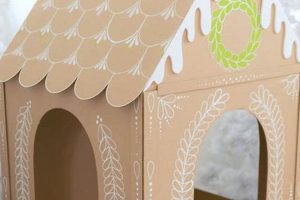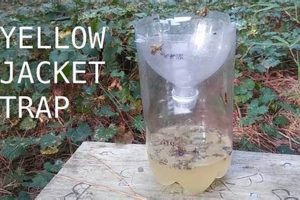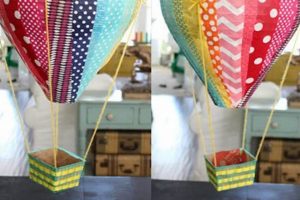A do-it-yourself spray enclosure is a self-constructed space designed to contain and ventilate fumes and overspray produced during painting projects. These structures range from simple, temporary setups using plastic sheeting to more elaborate, semi-permanent constructions with integrated ventilation systems. For example, a hobbyist restoring furniture in a garage might create a makeshift spray area using PVC pipes and plastic drop cloths.
The creation of a personal spray area offers several advantages, including cost savings compared to professional painting services, increased control over the painting environment, and the ability to perform finishing tasks at one’s own pace. Historically, such solutions have been popular among automotive enthusiasts, woodworkers, and hobbyists seeking to achieve professional-quality finishes without significant capital investment. They also allow users to customize the space to specific project needs and spatial constraints.
The following discussion will address essential considerations for constructing a functional and safe painting enclosure, including material selection, ventilation strategies, lighting requirements, and best practices for maintaining a clean and effective work environment. Proper planning and execution are crucial for maximizing the benefits while minimizing the risks associated with aerosolized paints and solvents.
Essential Guidance for Creating a Spray Enclosure
The construction of an effective and safe painting environment requires careful attention to several key factors. Implementing these recommendations will contribute to a higher-quality finish and a safer working environment.
Tip 1: Ventilation is Paramount: Adequate airflow is critical for removing hazardous fumes and overspray. Integrate a powerful exhaust fan sized appropriately for the enclosure’s volume. Ensure the fan vents to the exterior, away from windows and doors, and incorporates appropriate filtration to prevent environmental contamination.
Tip 2: Select Fire-Resistant Materials: Given the flammable nature of many paints and solvents, construction materials should be inherently fire-resistant or treated with a fire retardant. This includes the frame, walls, and any coverings used to create the enclosure.
Tip 3: Illumination Considerations: Sufficient and strategically placed lighting is crucial for achieving an even finish. Opt for explosion-proof LED fixtures to minimize the risk of ignition and provide consistent illumination across the work surface. Position lights to reduce shadows and glare.
Tip 4: Employ Adequate Filtration: Use high-quality filters in the exhaust system to capture particulate matter and prevent it from being released into the environment. Regularly inspect and replace filters according to the manufacturer’s recommendations to maintain optimal performance.
Tip 5: Seal the Enclosure Effectively: Properly sealing the perimeter of the enclosure minimizes overspray escaping into the surrounding area. Use durable tape and weather stripping to close gaps and ensure a tight seal. Inspect seals regularly and repair as needed.
Tip 6: Maintain a Clean Workspace: Regularly clean the interior of the enclosure to remove accumulated overspray and dust. This prevents contamination of future painting projects and reduces the risk of fire. Use appropriate cleaning agents that are compatible with the construction materials.
Tip 7: Static Electricity Mitigation: Static electricity can accumulate within the enclosure, posing a fire hazard. Grounding the frame and using anti-static materials can help to minimize this risk. Consider using a static-dissipative floor mat.
Adhering to these guidelines helps ensure a functional and safe area for painting, promoting professional results while mitigating potential hazards. Prioritizing safety and proper construction techniques is essential for a successful project.
The subsequent sections will delve into the practical application of these tips, offering specific examples and guidance for implementing them effectively in a home or workshop setting.
1. Ventilation System Capacity
Ventilation system capacity is a critical determinant of a do-it-yourself spray enclosure’s effectiveness and safety. Insufficient airflow can result in the accumulation of hazardous fumes and overspray within the enclosed space, posing health risks to the operator and increasing the potential for fire or explosion. A well-designed system draws air through the enclosure, removing paint particles and solvent vapors before they can concentrate. The capacity, typically measured in cubic feet per minute (CFM), must be matched to the size of the enclosure and the volume of paint being sprayed. For instance, a small booth for model painting requires considerably less CFM than a larger one designed for automotive parts.
The relationship between ventilation system capacity and the effectiveness of a spray enclosure can be observed in various practical applications. A low-CFM fan in a large enclosure might only circulate air without adequately extracting fumes, leading to poor visibility and potential respiratory irritation. Conversely, an appropriately sized fan, coupled with proper filtration, ensures a steady flow of clean air and a safe working environment. Example: A furniture refinisher using lacquer in a booth needs a fan with sufficient CFM to remove the highly flammable vapors, preventing accumulation and reducing the risk of fire. The placement of intake filters also plays a role; strategic positioning optimizes airflow and prevents dead zones within the enclosure.
In summary, ventilation system capacity is a non-negotiable aspect of a functional painting enclosure. Determining the correct CFM, coupled with appropriate filtration and design considerations, is essential for mitigating risks and ensuring a safe and effective painting environment. Choosing an undersized ventilation system negates many of the benefits of creating a contained spray area, increasing potential hazards. Proper planning and investment in adequate ventilation are fundamental to successful project outcomes.
2. Material Flammability Resistance
The selection of materials for a do-it-yourself spray enclosure is significantly influenced by their flammability resistance. The presence of volatile organic compounds (VOCs) in paints and solvents creates a highly flammable environment, making the choice of non-combustible or fire-retardant materials paramount for safety.
- Frame Construction Materials
The frame of the enclosure, whether constructed from wood, metal, or PVC, should exhibit high resistance to ignition and flame spread. Untreated wood, for instance, poses a significant fire risk due to its inherent flammability. Metal frames offer superior fire resistance but may require grounding to preve
nt static discharge. PVC can be treated with fire retardants to reduce its flammability. The choice of frame material directly impacts the overall safety of the spray enclosure. - Wall and Covering Materials
The walls and coverings of the enclosure, typically constructed from plastic sheeting or fabric, must also be fire-resistant. Standard polyethylene sheeting is highly flammable and should be avoided. Fire-retardant polyethylene or specialized spray booth fabrics are available and designed to inhibit flame spread. The use of appropriate covering materials minimizes the risk of a fire igniting and spreading rapidly within the enclosure.
- Filtration System Components
The filtration system, including the filters themselves, should be constructed from materials with low flammability. Some filter media can be combustible and contribute to the spread of fire if ignited. Selecting filters made from inherently fire-resistant materials or treated with flame retardants is crucial for preventing the filtration system from becoming a fire hazard.
- Sealing and Adhesive Products
The tapes, sealants, and adhesives used to construct and seal the spray enclosure should also be fire-resistant. Many standard tapes and adhesives are highly flammable and can contribute to the rapid spread of fire. Selecting products specifically formulated for fire resistance minimizes the risk of these materials acting as fuel in the event of a fire. The overall integrity of the fire-resistant barrier relies on the fire ratings of these components.
The collective fire resistance of all materials used in the spray enclosure determines its overall safety. Neglecting the flammability of any single component can compromise the fire resistance of the entire structure. The use of appropriate materials, combined with proper ventilation and fire safety practices, is essential for creating a safe and effective spray environment.
3. Light Source Suitability
The suitability of light sources within a do-it-yourself spray enclosure directly impacts the quality of the finished product and the safety of the operator. Inadequate illumination can lead to uneven paint application, missed imperfections, and potential eye strain for the user. Conversely, appropriately chosen lighting facilitates accurate color matching, consistent coverage, and a safer, more comfortable working environment. Therefore, proper consideration of light source characteristics is crucial for optimal results and user well-being within the confines of a self-constructed spray booth.
Factors influencing light source suitability include color temperature, intensity, and explosion-proof rating. Color temperature, measured in Kelvin (K), affects how colors are perceived; a neutral white light (around 5000K) is often preferred for accurate color representation. Insufficient intensity, measured in lumens, obscures surface irregularities. Explosion-proof ratings are essential due to the presence of flammable solvents; standard light fixtures pose a significant ignition risk. Example: Installing standard fluorescent lights in a paint area risks ignition from vapors, while using explosion-proof LED fixtures provides bright, safe illumination, enhancing visibility and paint finish quality. This reduces rework caused by unnoticed imperfections.
In conclusion, light source selection for a painting enclosure demands a comprehensive understanding of safety requirements and the impact of lighting on visual accuracy. The benefits of investing in appropriate lighting significantly outweigh the initial cost, leading to improved finish quality, reduced waste, and a safer working environment. Overlooking the importance of light source suitability presents challenges related to product quality and user safety, underscoring the crucial role of proper illumination within the broader context of creating a functional and safe painting space.
4. Filtration System Efficiency
Filtration system efficiency is a cornerstone of a functional and safe do-it-yourself spray enclosure. The primary function of a filtration system within a spray enclosure is to remove particulate matter and volatile organic compounds (VOCs) from the air stream before it is exhausted to the external environment. Inefficient filtration results in the release of harmful pollutants, potentially violating environmental regulations and posing health risks to individuals in the vicinity. The connection between filtration system efficiency and spray booth functionality is direct: higher efficiency translates to cleaner air, reduced overspray contamination, and a safer working environment.
The effectiveness of a filtration system is typically measured by its Minimum Efficiency Reporting Value (MERV) rating. A higher MERV rating indicates a greater ability to capture smaller particles. For example, a MERV 8 filter will capture significantly fewer fine particles than a MERV 13 filter. The choice of filter depends on the type of paint being used and the sensitivity of the surrounding environment. Automotive paints, which often contain hazardous VOCs, require high-efficiency filters to adequately protect air quality. Without proper filtration, overspray can accumulate on surfaces outside the booth, requiring additional cleanup and potentially damaging property. A real-world example is the application of an inadequate filter system in a woodworking shop, where fine dust particles escaped, creating a health hazard for workers and coating nearby equipment with a layer of sanding dust.
In conclusion, filtration system efficiency is not merely an ancillary consideration but a fundamental requirement for a responsible and effective do-it-yourself spray enclosure. Selecting filters appropriate for the specific application, maintaining a regular filter replacement schedule, and ensuring a proper seal within the filtration system are crucial steps in protecting both the environment and the health of those using the spray booth. The practical significance lies in reducing risks, ensuring compliance with regulations, and promoting responsible painting practices. Failure to prioritize filtration system efficiency can negate the benefits of creating a controlled spray environment, leading to undesirable consequences.
5. Structural Integrity, Sealing
The structural integrity and sealing of a self-constructed spray enclosure directly influence its ability to contain overspray and fumes effectively. A structurally unsound booth risks collapse, compromising containment and potentially causing injury. Deficient sealing allows paint particles and volatile compounds to escape, negating the environmental control benefits and creating a hazardous working environment. Thus, both structural integrity and sealing are not merely desirable attributes, but rather, essential components that dictate the functional performance and safety of a painting area.
A robust framework constructed from durable materials, such as steel or reinforced wood, provides the necessary stability to withstand internal pressure from ventilation systems and external environmental factors. Careful joint construction, using
appropriate fasteners and adhesives, ensures the structure maintains its shape under stress. Proper sealing techniques, employing airtight membranes, durable tapes, and weather stripping, prevent the egress of contaminants. Consider, for example, a situation where a booth constructed from flimsy plastic sheeting and poorly sealed seams allows overspray to drift into the surrounding workshop, contaminating other projects and exposing individuals to harmful substances. Conversely, a well-engineered and carefully sealed enclosure minimizes contamination, maintains proper ventilation, and ensures a safer and more efficient painting process. The practical significance lies in the reduction of health risks, the minimization of cleanup efforts, and the enhancement of overall finish quality.
In summary, structural integrity and effective sealing form the foundation of a successful and safe painting enclosure. Compromising either aspect can lead to significant performance deficiencies and potential hazards. Prioritizing robust construction techniques, selecting appropriate sealing materials, and meticulously addressing potential leakage points are crucial steps in creating an environment that effectively contains overspray and fumes. The long-term success and safety of a DIY paint booth are inextricably linked to the quality of its structural framework and the effectiveness of its sealing mechanisms.
Frequently Asked Questions
This section addresses common inquiries and concerns regarding the construction and operation of a self-made spray enclosure, providing clarity on best practices and potential challenges.
Question 1: What is the minimum ventilation requirement for a DIY paint booth to ensure operator safety?
The minimum ventilation requirement is dependent on the size of the enclosure and the type of coating being applied. A general guideline is to aim for at least four air changes per hour (ACH). Consult local regulations and safety data sheets (SDS) for specific coating materials for precise ventilation requirements and applicable standards.
Question 2: Can a standard box fan be used for ventilation in a DIY paint booth?
The utilization of a standard box fan is strongly discouraged due to the potential for ignition of flammable vapors. Standard box fans are not typically explosion-proof and lack the necessary filtration capabilities for safe operation. A purpose-built exhaust fan designed for spray booth applications is required.
Question 3: What are the key considerations when selecting a filter for a DIY paint booth?
Filter selection should be based on the type of particulate matter generated and the desired level of filtration efficiency. Filters are rated using the Minimum Efficiency Reporting Value (MERV). Higher MERV ratings indicate greater filtration efficiency. Consult the safety data sheet (SDS) for the coatings being used to determine appropriate filter specifications.
Question 4: Is it necessary to ground a metal-framed DIY paint booth?
Grounding a metal-framed enclosure is highly recommended to mitigate the risk of static electricity buildup, which can ignite flammable vapors. A properly grounded booth provides a path for static charges to dissipate safely, reducing the potential for fire or explosion. Consult electrical codes for proper grounding procedures.
Question 5: What type of lighting is safe to use inside a DIY paint booth?
Only explosion-proof lighting fixtures are safe for use inside a spray enclosure. Standard lighting fixtures can generate sparks that may ignite flammable vapors. Explosion-proof fixtures are designed to contain any internal ignition, preventing the spread of fire. Ensure fixtures are rated for the specific environment and meet relevant safety standards.
Question 6: How often should filters be replaced in a DIY paint booth?
Filter replacement frequency depends on the volume of paint sprayed and the type of filter used. Regularly inspect filters for signs of clogging or saturation. A reduction in airflow through the enclosure indicates the need for filter replacement. Follow the filter manufacturer’s recommendations for optimal performance and safety.
Proper planning, material selection, and adherence to safety guidelines are paramount for constructing and operating a self-made spray enclosure. Failure to address these critical factors can compromise safety and lead to unsatisfactory results.
The subsequent section will explore advanced techniques for optimizing the performance of a self-constructed spray booth, including airflow management and environmental control strategies.
In Conclusion
This exposition has illuminated critical aspects of the diy paint booth, emphasizing the importance of careful planning, material selection, and adherence to safety protocols. The discussion underscored the necessity of adequate ventilation, fire-resistant construction, appropriate lighting, and effective filtration to create a functional and secure painting environment. Key considerations include ventilation capacity, material flammability, light source suitability, and filtration system efficiency. The structural integrity and proper sealing of the enclosure were also identified as vital to preventing the escape of overspray and hazardous fumes. The FAQs addressed common concerns regarding safety requirements and best practices for building and operating a self-made spray area.
The construction and utilization of such a controlled environment demands a comprehensive understanding of the inherent risks associated with aerosolized paints and solvents. While a diy paint booth offers potential cost savings and project control, it also necessitates a commitment to rigorous safety standards and continuous monitoring of operational parameters. Therefore, individuals embarking on this endeavor are urged to prioritize safety above all else and to consult relevant regulations and safety guidelines before commencing construction and operation. Diligence and informed decision-making are paramount for ensuring a safe and successful painting outcome.







